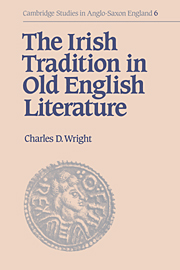Book contents
- Frontmatter
- Contents
- Acknowledgements
- List of abbreviations
- 1 Introduction
- 2 The ‘enumerative style’ in Ireland and Anglo-Saxon England
- 3 The Visio S. Pauli and the Insular vision of hell
- 4 Apocryphal cosmology and Celtic myth in ‘The Devil's Account of the Next World’
- 5 The literary milieu of Vercelli IX and the Irish tradition in Old English literature
- Appendix: Vercelli Homily IX and ‘The Devil's Account of the Next World’
- Bibliography
- Index
4 - Apocryphal cosmology and Celtic myth in ‘The Devil's Account of the Next World’
Published online by Cambridge University Press: 18 March 2010
- Frontmatter
- Contents
- Acknowledgements
- List of abbreviations
- 1 Introduction
- 2 The ‘enumerative style’ in Ireland and Anglo-Saxon England
- 3 The Visio S. Pauli and the Insular vision of hell
- 4 Apocryphal cosmology and Celtic myth in ‘The Devil's Account of the Next World’
- 5 The literary milieu of Vercelli IX and the Irish tradition in Old English literature
- Appendix: Vercelli Homily IX and ‘The Devil's Account of the Next World’
- Bibliography
- Index
Summary
To judge from the surviving copies and variant versions, ‘ The Devil's Account of the Next World’ was among the most popular religious tales in late Anglo-Saxon England. Its genre and literary antecedents have not been fully investigated, but Fred C. Robinson has pointed in the right direction by suggesting that the tale ‘resembles the narratives gathered into the so-called Vitas Patrum’. The Vitas patrum is a massive and diverse collection that includes ‘ Lives’ in the normal sense of the word, such as Jerome's Vita S. Pauli together with monastic histories (including the Historia monachorum translated by Rufinus) and the collections of anecdotes known as the Verba seniorum. Though of varied origins, these works are unified by a common subject: the desert fathers, the hermits and anchorites of Egypt, Syria and Palestine. The anecdotes in the Verba seniorum (a term which embraces more than one group of texts) are a series of disconnected vignettes, often little more than a maxim with the barest narrative framework. The protagonists are sometimes nameless, but even when they are identified no individual portrait emerges from the blank face of sanctity. Encounters with the devil are the focus of many anecdotes, and there are a number of tales (often attached to the figure of Macarius) in which a hermit receives a report or a vision of the Otherworld or of the struggle of angels and demons over the soul at death. Inspired by such tales, a great many later medieval exempla also feature hermits and devils.
- Type
- Chapter
- Information
- The Irish Tradition in Old English Literature , pp. 175 - 214Publisher: Cambridge University PressPrint publication year: 1993



